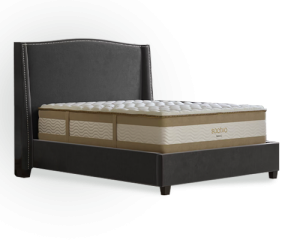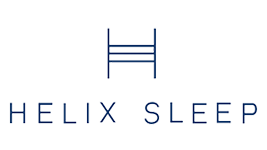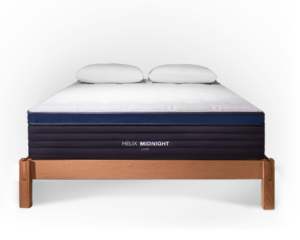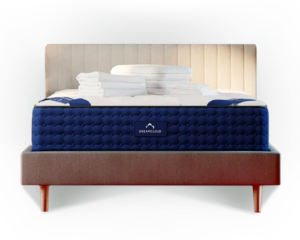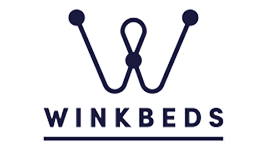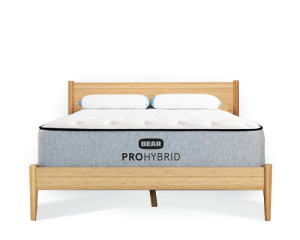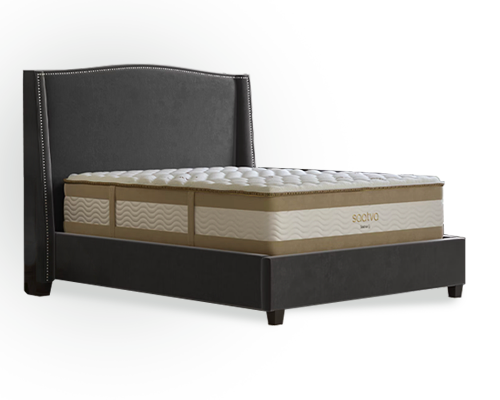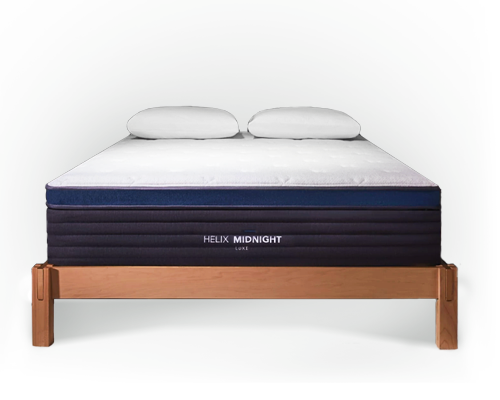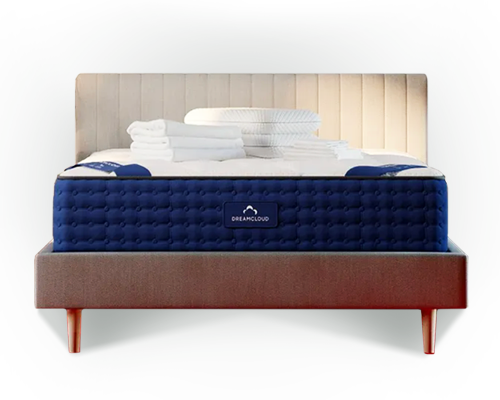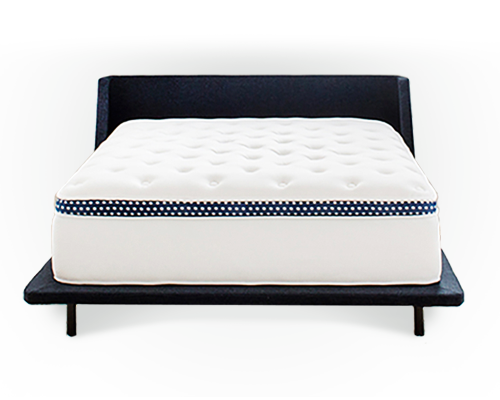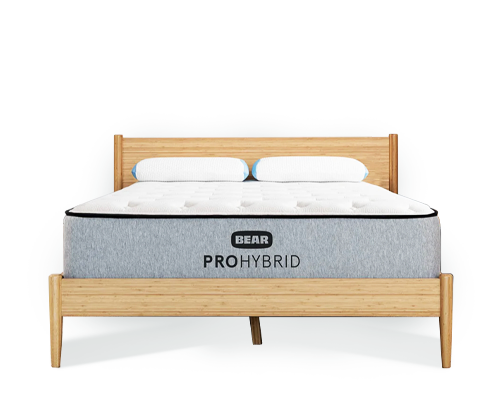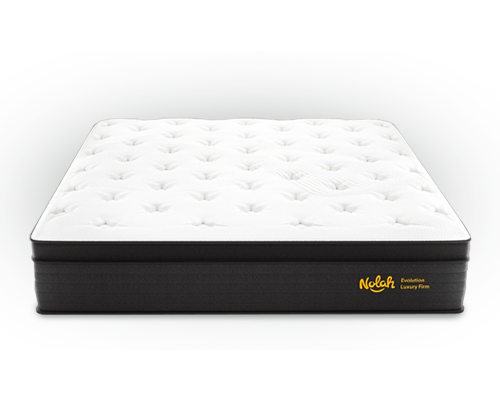- Price: $3,295 for a queen-size before discounts
- Material: Hybrid
- Brand’s firmness rating: Supportive plush
- Mattress height: 15 inches (″)
- Trial period: 365 nights
- Shipping: Free with white-glove delivery included
- Warranty: Limited lifetime
- Offers financing: Yes
Best Mattress for Osteoporosis in 2025 Reviewed by Experts
Key Takeaways
- The best mattress for osteoporosis is the Saatva Rx for its adaptability, comfort, and mobility-boosting features.
- Mattresses in our roundup cost between $1,332–$3,295 for a queen size.
- Sleep and bone health are directly related, so it’s important to find a comfortable mattress that encourages safe and easy movement to prevent future injury.
- If you’re unsure how to manage your osteoporosis, seek guidance from a health care professional.
Shopping for a new bed can feel overwhelming with all the options online and in-store, especially when shopping with medical conditions in mind. For people with osteoporosis, comfort, bedroom safety, and moving around easily in bed are top of mind. But how do we narrow down our choices?
Our skilled team researched and tested more than 130 mattresses to develop this list of the best mattresses for osteoporosis. We hope our list helps you find a mattress or understand what features and services are most helpful.
Best mattress for osteoporosis in 2025
- Saatva Rx: Best Overall Mattress for Osteoporosis
- Helix Midnight Luxe: Best for Side Sleepers with Osteoporosis
- DreamCloud Memory Foam: Best Mattress for Couples with Osteoporosis
- The WinkBed: Best Hybrid Mattress for Osteoporosis
- Bear Pro Hybrid: Best Mattress for Back Sleepers with Osteoporosis
- Nolah Evolution 15″: Best for Osteoporosis and Back Pain
- Brooklyn Bedding Signature Hybrid: Best Affordable Mattress for Osteoporosis
What we look for in a mattress for osteoporosis
We found several important factors when testing mattresses specifically for osteoporosis, including:

Comfort
A medium-to-firm mattress with good spine support and pressure relief helps you sleep better throughout the night, which supports bone health.

Mattress height
We chose different mattresses varying in height to accommodate taller or shorter people and their movement needs.

Functional support
A functionally supportive mattress encourages easier and safer movement, like getting out of bed, to help prevent falls.

White-glove delivery
Not all brands offer white-glove delivery (shipping and setup of new mattress and removal of old mattress), but we listed a few that do to save you from risking injury.
Saatva Rx: Best Mattress for Osteoporosis Overall
Our expert take on the Saatva Rx mattress
The Saatva Rx is comfortable and adaptable, supports moving around more safely in bed, and offers free white-glove delivery for easy setup. It checks all our boxes, earning the best mattress for osteoporosis.
Our team was impressed by this 15-inch-tall hybrid mattress’s ability to adapt to our body shape and
respondⓘ
Responsiveness describes how much surface bounce a mattress has and how it responds to pressure or the sleeper’s movements, making it easier to move around and change sleeping positions.
to our movement. Switching positions and getting out of bed felt easy due to its bouncy, supportive, and lofty build. But shorter people may find it difficult to navigate unless it’s paired with a short bed frame.
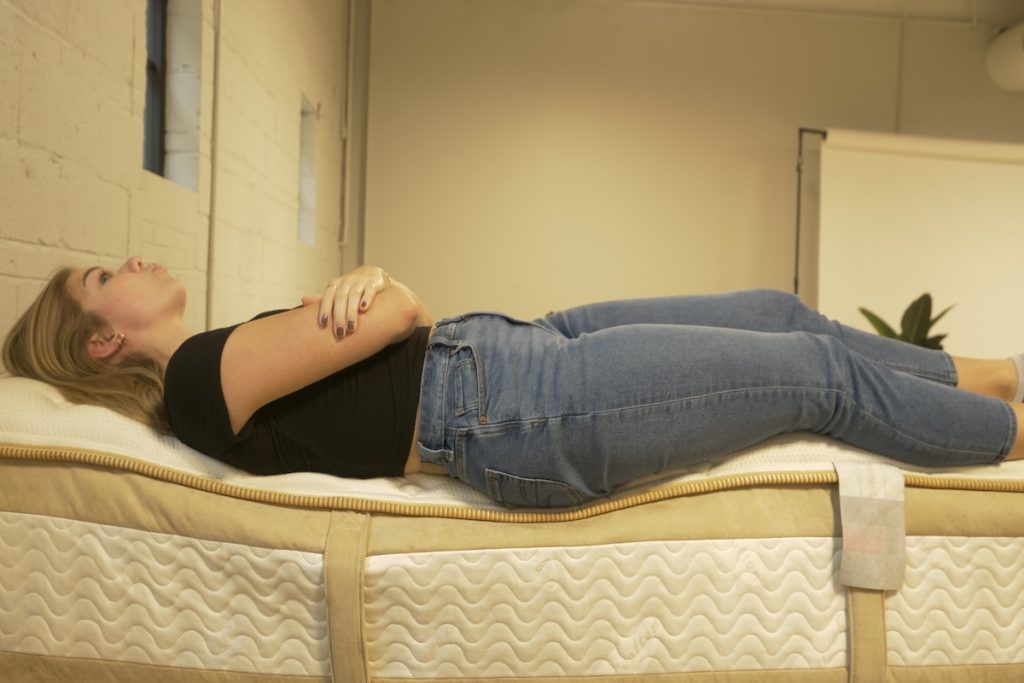
We also appreciated how comfortable the Saatva Rx felt. It has seven foam and coil layers, which help balance support and cushion. Unlike other mattresses in our review, the Saatva Rx has foam-capped springs for better motion isolation and weight distribution across the mattress while still encouraging airflow through the large coil layers for cooling. This cooling mattress also has a micro-coil layer to contour and support your body’s unique curves. This design helps maintain spinal alignment for a more comfortable night’s sleep. According to research, adequate sleep supports bone health by decreasing the risk of falls from daytime drowsiness.
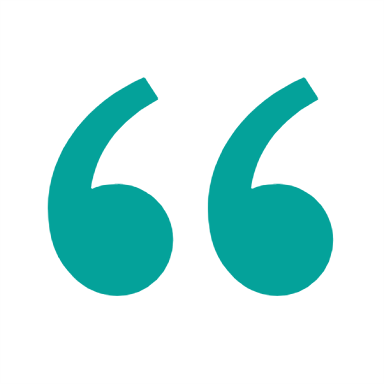
Our tester on the Saatva Rx mattress:
“The Saatva Rx conforms to my body well and reinforces my spine. Its support targets my lower back, which I find very comfortable.”
To our knowledge, Saatva is the only brand in the industry with complimentary white-glove delivery. This means you won’t need to worry about lifting and carrying this mattress into your bedroom when it arrives. You also get a limited lifetime warranty and a 365-night trial period, which is plenty of time to test your bed at home.
Based on our extensive research and testing, Saatva is one of the best brands on the market. Check out more of our top overall picks in our best mattresses roundup.
Our recommendation
Who may love it
- Solo sleepers or couples looking for maximum lower back support for comfort (or to help manage pain)
- Those who prefer a solid, tall mattress to switch positions and get out of bed easily
- Anyone who needs help setting up their new bed
Who may want to avoid it
- Shoppers on a budget who need less expensive options
- Shorter people with tall bed frames who need a shorter mattress
Customer reviews
The Saatva Rx has a 4.9-star rating out of five and more than 70 reviews on the brand’s website. Many positive reviews describe overall comfort and relief, but the most common praise is for its customer support.
“I’ve only had the mattress six days but is very comfortable. I purchased the mattress online by reading the reviews and other info I could find. The delivery folks were excellent. Very courteous. Took the old mattress and set up the new one. The delivery service notified me of the time window and date the day before. They answered all my questions. Saatva also has great customer service. They actually call you! Instead of emails, chats, etc. to answer and resolve questions.”
— Paul, verified buyer on 4/24/2024
“Superb customer service, technical support, delivery, and the mattress itself for my 67-year-old back with 20 years of serious orthopedic problems!”
— Ruth, verified buyer on 10/12/2023
We only came across a few verified negative reviews. One reported a bad experience with their delivery, stating they canceled the order due to delays. Another was disappointed in the setup process of their mattress and adjustable base because of missing parts.
For more information, see our in-depth Saatva review or our Saatva Rx review.
Helix Midnight Luxe: Best Mattress for Side Sleepers with Osteoporosis
Our expert take on the Helix Midnight Luxe mattress
Side sleepers need a slightly softer mattress with enough pressure relief to prevent tossing and turning for a more comfortable position. They also need support at the midsection to prevent uncomfortable sagging throughout the night (and over time). The Helix Midnight Luxe ticks these boxes while providing a tall, functionally supportive surface for people with osteoporosis.
This mattress has a thick pillow top layer with foam designed to cradle the body. The coils underneath offer zoned support, which is a strip of reinforced coils along the center of the mattress with softer coils above and below where the hip and shoulder rest. Together, the foam and coils redistribute weight across the mattress to eliminate pressure points, prevent sag, and encourage spinal alignment while side sleeping. If you also have general lower back pain, research has shown that zoned support is a comfortable and pain-relieving design.
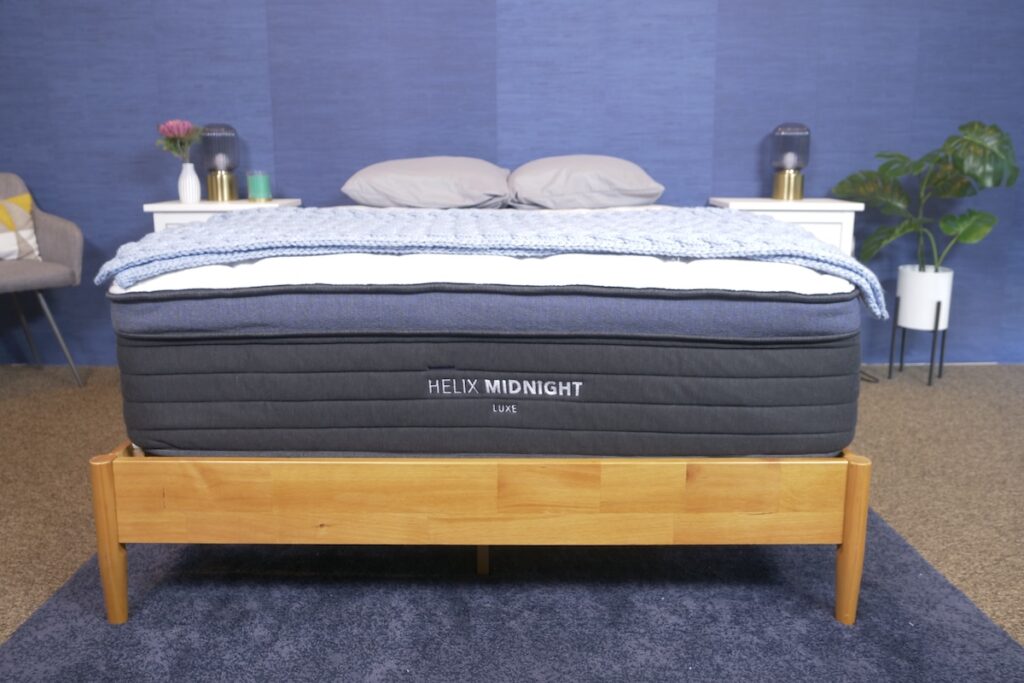
But comfort is only part of the picture. People with osteoporosis also need sag-resistant edges to prevent sliding off while getting out of bed or sitting to put on pants. The Helix Midnight Luxe has great edge support, dipping slightly through the pillow top with support at the coil layer. Testers felt stable lying or sitting at the edge without fear of falling or slipping.

Our tester on the Helix Midnight Luxe mattress:
“Changing positions on this mattress took a little more effort than firmer options because of the pillowtop, but otherwise, I thought it was easy to push up to standing due to the mattress’s height and sturdy edges.”
The Helix Midnight Luxe has a 100-night trial period and a 15-year warranty. Like most bed-in-a-box companies, Helix doesn’t offer white-glove delivery. We recommend you call a local furniture moving company to help you set up the mattress when it arrives at your doorstep.
Our recommendation
Who may love it
- Side sleepers looking for a medium-soft mattress with pressure relief at the joints without sacrificing support
- People who want a borderline-soft mattress that feels relatively easy to move on
- Hot sleepers who want a contoured feel without the heat-trapping qualities of an all-foam bed
Who may want to avoid it
- Those with osteoporosis and weakness who need a firmer surface to switch positions more easily
- People who don’t have help to move the mattress into the bedroom after delivery
Customer reviews
The Helix Midnight Luxe has a 4.4-star rating out of five, with more than 6,100 reviews on the brand’s website. Many side sleepers left positive reviews.
“I have better sleep now because of purchasing this mattress. I’m mostly a side and back sleeper, but I am a lightweight person, and this mattress felt great. I sleep the whole night through now compared to my older mattress. Thanks, Helix!”
— Julia G., verified buyer on 3/26/2024
“The mattress has been a huge improvement for my wife, who is a side sleeper and has been experiencing hip pain. The mattress has also been good for me as a back sleeper. We are looking forward to improved sleep in the summer due to the cooling layer.”
— Antonio G., verified buyer on 3/3/2024
We found a few negative reviews saying the mattress has softer edges than expected and a different firmness level (both softer and firmer were reported). According to our testing results, the mattress does have some give through the pillow top layer, but it didn’t feel unsteady to our tester, who weighs roughly 130 pounds. But sleepers with other body types may experience firmness and edge support differently.
For more information, see our in-depth Helix Midnight Luxe review.
DreamCloud Memory Foam: Best Mattress for Couples With Osteoporosis
Our expert take on the DreamCloud Memory Foam mattress
The DreamCloud Memory Foam mattress is great for couples with osteoporosis because its medium-firm contouring yet supportive surface accommodates different sleep partners’ preferences without making it difficult to move around on. When we tested motion isolation, we were impressed by how well the all-foam mattress dampened movement across the surface.

Sleeping with a restless partner can disturb your sleep, especially on bouncy surfaces. The DreamCloud Memory Foam earned top marks for its motion isolation due to its foam build, which dampens motion well. But some foams sink, making sleepers feel stuck in their mattress. Although this mattress doesn’t bounce back as quickly as an innerspring or hybrid, it felt relatively dense and easy to navigate for our testers. Switching positions and getting out of bed felt surprisingly easy, especially if you’re on the shorter side and are used to a shorter mattress.

Our tester on the DreamCloud Memory Foam mattress:
“We tested motion isolation by placing a glass of water on one side and sitting on the other. After climbing into bed and switching positions, the glass barely budged. To us, that’s a perfect score.”
If you and your partner want extra help with changing positions in bed, you can bundle the DreamCloud Memory Foam mattress with an adjustable bed for $4,218 for a queen-size (but with frequent promotions, you can get it for under $2,000). This allows you to use a remote control to lift the mattress’s head and get out of bed more easily. These adjustments may also improve comfort or relieve pain, depending on your need. Couples with different preferences can opt for a split king adjustable base instead (less than $3,000 with promotions), which allows independent adjustments on either side.

“Everything was new to me. I hadn’t gotten a mattress in a long time. I got the adjustable frame, so that was all new to me. I had to figure out what would, what’s the best way for me to adjust my bed so I don’t suffer with pains, headaches, neck pains. And so after working with it for three days, adjusting the bed the way I wanted it, it worked out good. I mean, I sleep too much.”
— Focus group participant with osteoporosis, age 73, side sleeper
This mattress has a generous one-year trial period and a limited lifetime warranty. But it doesn’t offer white-glove delivery if you order the mattress alone. It’s only available if you purchase the bundle. Get more adjustable options by reading our roundup of the best adjustable beds.
Our recommendation
Who may love it
- Couples with osteoporosis who want quality, undisturbed sleep
- Those who are also considering an adjustable bed for comfort or easy movement
- People who like memory foam but are concerned about feeling stuck in bed
- Anyone on a strict budget
Who may want to avoid it
- Side sleepers weighing less than 130 pounds who need a plusher surface
- Taller people who need a mattress that’s high enough to easily stand from
Customer reviews
The DreamCloud Memory Foam mattress has a 4.6-star rating out of five with more than 8,900 reviews on its website. Many couples left positive reviews, reporting a more comfortable sleep.
“I had been looking for a new mattress for my wife and me. I’m a stomach sleeper, and she is a side/back sleeper. I have been amazed by the comfort the bed has provided. I have had numerous mattresses prior to my upgrade to DreamCloud. 10/10 recommend.”
— Gaberiel J., verified buyer on 4/30/2024
“I love my new mattress, I am sleeping better through the night and it works well with the new adjustable frames also. My wife loves hers but says it needs a cooling pad (she has hot flashes).”
— James C., verified buyer on 3/9/2024
On Google, we found negative reviews about DreamCloud. Many recent negative reviews cite delayed delivery or a difficult returns process. Most mattresses ask you to keep your purchase for a 30-day adjustment period to allow your body to adapt, so make sure you read and agree with the terms before buying. Other negative reviews said the mattress felt firmer or softer than expected, although there wasn’t a clear consensus.
For more information, see our in-depth DreamCloud review.
The WinkBed: Best Hybrid Mattress for Osteoporosis
Our expert take on The WinkBed mattress
The WinkBed is one of our team’s favorite respondⓘ Hybrid mattresses combine the features of both innerspring and foam mattresses, with springs surrounded by a thick comfort layer of foam or latex. 1 mattresses because it combines bouncy coils and targeted lower back support with a pressure-relieving Euro pillow top. The coils and pillow top work together to balance comfort and function. Our team enjoyed this mattress in every sleep position and found it easy to move around on, making it a great choice for people with osteoporosis.

Our tester on The Winkbed mattress:
“This mattress is easy to move on because I’m not working against the fabric. I like having the mattress slightly taller so I can slide off the edge slightly and place my feet on the ground to stand up. But I still feel secure—the edge sinks slightly through the foam, but I don’t feel like I’ll fall off.”
Our team also appreciates how WinkBeds offers multiple firmness options for people with different preferences. According to our testing, WinkBeds has tested true to its firmness level. We recommend the luxury firm model as a good middle ground, although the firmer or softer versions may better cater to your specific needs. Firmer beds tend to offer more functional support, so if you’d like more of a boost getting out of bed, opt for the firmer version—although you may sacrifice pressure relief for the denser feel.

WinkBeds offers a 120-night trial period and a lifetime warranty. The brand doesn’t currently offer white-glove delivery, but it offers a unique exchange program to help you find the right firmness. If you’re unhappy with the firmness level you chose, you can exchange it for another option for $49. Then, you can keep both mattresses for up to 60 nights while deciding which works best for you.
Our recommendation
Who may love it
- People who love hybrids for a balanced amount of bounce and cushion
- Those with osteoporosis and back pain who appreciate targeted support for relief
- People who need a small boost of help from their mattress to get out of bed or switch positions easily
Who may want to avoid it
- Higher-weight (more than 250 pounds) stomach sleepers may perceive this mattress as too soft
- People who need help to move the mattress into the bedroom after delivery
Customer reviews
The WinkBed has a 4.8-star rating out of five, with more than 8,600 reviews on the brand’s website. Many people left positive reviews about the mattress’s overall feel and the exchange process.
“We love the mattress so far! Have had it for about a month. It’s got a good level of support, not too hard, not too soft, so you just don’t think about what you’re laying on. Haven’t had as many aches and pains when waking up.”
— Jennifer D., verified buyer on 2/3/2024
“Overall comfortable, but too firm for us. We swapped for the softer WinkBed and are sleeping great now!”
— Micah T., verified buyer on 2/6/2024
But we also saw some negative reviews mentioning delayed delivery and difficulty adjusting to the new feel. A relatively softer hybrid bed may feel foreign to your body if you’re used to a firmer innerspring or a worn mattress with compressed foam. For this reason, many mattress brands require you to keep your mattress for up to 30 days before initiating returns to allow the body to adjust before you make your final decision. Thankfully, we didn’t see many negative reviews about customer service, so exchanging or returning the mattress is always an option.
For more information, see our in-depth WinkBed mattress review.
Bear Pro Hybrid: Best Mattress for Back Sleepers
Our expert take on the Bear Pro Hybrid mattress
The Bear Pro Hybrid is ideal for back sleepers seeking the conforming feel of memory foam with the support of coils. Like The WinkBed, both materials create a comfortable yet supportive sleeping surface. But the Bear Pro Hybrid conforms to back sleepers of almost any body type with a higher functional support score. This means rolling over from your back to your side as you get out of bed should feel easier and safer with osteoporosis.

Our tester on the Bear Pro Hybrid mattress:
“This mattress is good for back sleepers of average or higher weight. For a lighter-weight (less than 130 pounds) sleeper like myself, I don’t sink as much into the dense foam layer on top, so the mattress doesn’t conform to my back to provide strong reinforcement. It’s still supportive, and I feel like my spine is aligned with good weight distribution, but it’s best suited for people over 130 pounds.”
At just 10 inches, this mattress is one of the shorter options. We don’t recommend this height to taller people who may find it difficult to stand from a low surface, but shorter people may prefer it, especially if their bed frame is tall. We interviewed a group of older adults about their recent experience purchasing a new mattress, two of whom were women with osteoporosis. Both women mentioned how they preferred a shorter mattress because it felt safer to climb into without needing a step stool. If you can relate, the Bear Pro Hybrid or any other mattress under 13 inches (what we consider short) should work best, depending on the height of your existing frame.
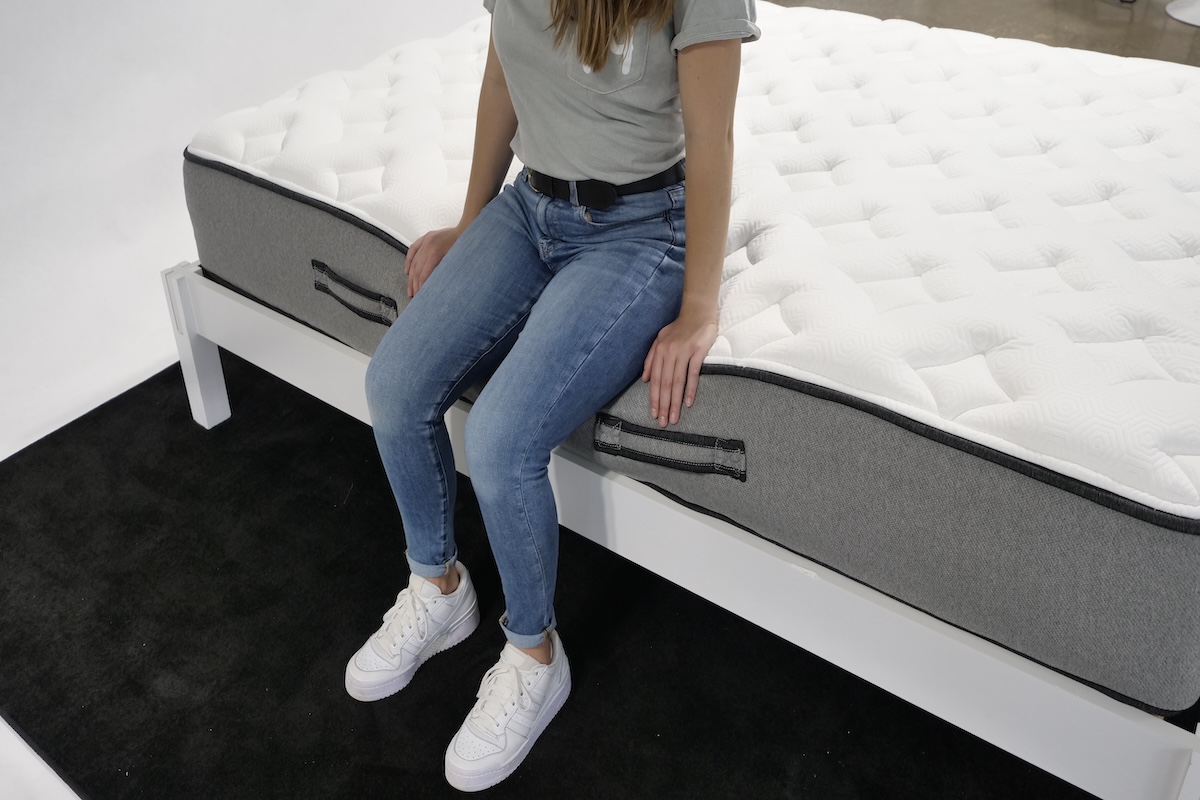
This mattress comes with a 120-night trial period and a limited lifetime warranty. White-glove delivery is available for $175, but you must add it to your cart before you check out. You’ll find White Glove Service under “Support” on the website’s footer. If you purchase this mattress during frequent promotions, you can get a queen-size for less than $1,000, potentially allowing space in your budget for the service.
Check out our best firm mattress review if you’re browsing firm beds.
Our recommendation
Who may love it
- Back sleepers with osteoporosis looking for a firmer mattress that allows easier movement in bed without sacrificing comfort
- Shorter people who feel safer moving on a shorter bed
- People sticking to a budget
Who may want to avoid it
- Higher-weight stomach sleepers may perceive this mattress as too forgiving
- Taller people with shorter bed frames may find it difficult to get out of a short mattress
Customer reviews
The Bear Pro Hybrid has a 4.5-star rating out of five with more than 50 reviews on the brand’s website. Many people rated the mattress as medium-firm to firm (similar to our test results). We also read positive reviews from back sleepers who stated the bed felt comfortable and encouraged a better night’s sleep.
“I was skeptical about buying a mattress online … But my wife did a lot of research and thought this was the one. She was right of course. Unbelievable. Best sleep both of us have ever had. Night after night it delivers. Complete recommendation and we have to several other people.”
— Gordon S., verified buyer (back and side sleeper) on 1/17/2024
“I spent a lot of time choosing a mattress and I couldn’t be happier with my Bear mattress. It’s truly dreamy. I’ve always had very firm spring mattresses and thought that was best for me. Turns out a hybrid was better as it gives more lower back support. After reading a wild number of reviews for back sleepers, I settled on this and have slept so well since I received it.”
— Laura C., verified buyer (back sleeper) on 10/6/2023
We also saw some negative reviews from customers who received their order damaged, preferred a thicker mattress, or wished for stronger support. As our tester mentioned in the quote above, firm mattresses don’t allow the hips to sink into the surface if you’re lighter weight. Some people like feeling “on” their mattress, but those who want more reinforcement under the lower back need more contour to allow the material to meet the spine and support it.
For more information, see our in-depth Bear mattress review.
Nolah Evolution 15″: Best Mattress for Osteoporosis and Back Pain
Our expert take on the Nolah Evolution 15″ mattress
The Nolah Evolution 15″ is one of the best mattresses for back pain because it scored high for pressure relief and support due to its unique design. Nolah incorporates its trademarked AirFoam into this mattress to provide gentle zoned lower back support, which our team enjoyed in every sleep position. According to research published in Sleep Science and Practice, people with osteoporosis commonly report back pain, and zoned support has the potential to help.
Our testers liked how they didn’t need to fight material to switch positions or get out of bed. Sitting or lying close to the edge of the bed felt safe because the edges are reinforced well, only sinking 2.5 inches through the top foam layer until our body was met with sturdy coils. Considering this mattress is 15 inches tall, a 2.5-inch sinkage didn’t feel significant.
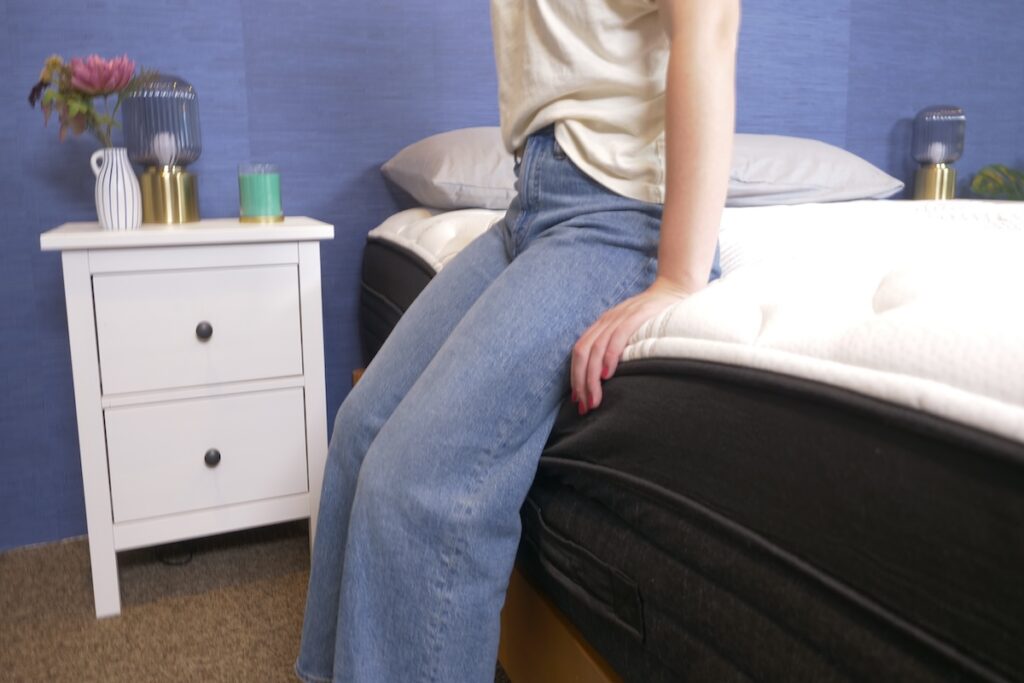
Although the 15-inch height may feel easy to navigate for taller people, others on the shorter side may need a step stool to get in and out of bed, depending on the height of your existing bed frame. Relying on a stool isn’t the safest option and can lead to falls if you’re not careful. Instead, we recommend pairing the Nolah Evolution 15″ with a shorter frame or a shorter mattress with zoned support (like The WinkBed).

Our tester on the Nolah Evolution 15″ mattress:
“I felt like I was sinking into the mattress a perfect amount. It contoured my body without sucking me in, but it also supported my curves really well no matter my position.”
You get a 120-night trial period and a limited lifetime warranty when you purchase this mattress. Nolah offers white-glove delivery through a third party called Load Up, although it costs between $150–$300, depending on the items you need moved. It’s costly, but we recommend finding help to move this bulky mattress.
Our recommendation
Who may love it
- Anyone with osteoporosis and back pain seeking a highly supportive mattress
- Taller people who need a high, firm mattress to safely and easily get out of bed
- People with sore areas at the hips or shoulders who benefit from as much pressure relief as possible
Who may want to avoid it
- People who are shopping on a budget
- Shorter people with high bed frames who need a lower mattress
Customer reviews
The Nolah Evolution 15″ has a 4.9-star rating out of five on the brand’s website. We noticed a few positive reviews from customers (some with back pain) reporting a more comfortable night’s sleep after their purchase.
“This mattress is very comfortable and of high quality. I’m sleeping much better since I bought it. Thank you, Nolah people!”
— Andrew C., verified buyer on 2/19/2024
“We love our Nolah, we both wake up rested with much less aches and pains.”
— Ondria G., verified buyer on 10/4/2023
We also noticed some negative reviews with customers reporting the mattress feels softer or firmer than expected. One customer who thought the mattress was too firm got a mattress topper to soften the surface, which worked. A mattress topper is a good solution if you run into a similar issue after your trial period is up.
For more information, see our in-depth Nolah mattress review.
Brooklyn Bedding Signature Hybrid: Best Affordable Mattress for Osteoporosis
Our expert take on the Brooklyn Bedding Signature Hybrid mattress
For people on a strict budget looking for a comfortable and functional bed to accommodate osteoporosis, the medium-firm version of the Brooklyn Bedding Signature Hybrid may be an ideal option. Our testers felt this mattress was softer, at six out of 10 on the firmness scale, but it’s responsive enough to help you switch positions or easily get out of bed. Although it costs less than other mattresses in this review, its thick, soft cover felt high-quality and cozy in most positions.
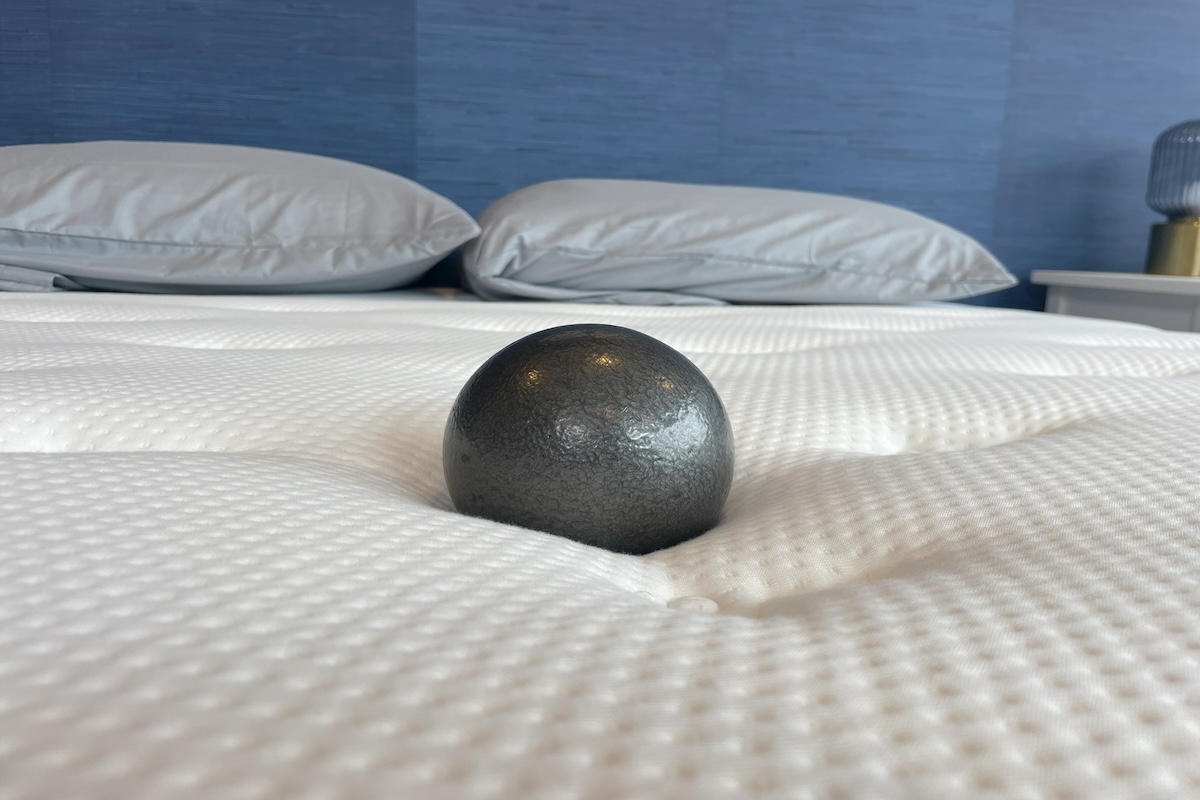

Our tester on the Brooklyn Bedding Signature Hybrid mattress:
“This bed feels slightly soft, but it’s still supportive. As someone of average weight (130–250 pounds), I feel it’s best for back sleeping, but it also works for side and stomach sleepers. Moving around isn’t difficult because the bed pops right back up when I change positions, but there are more mobility-boosting options. It’s a good option if you like a softer mattress that doesn’t hinder your movement.”
Since the Signature Hybrid is just above 12 inches tall, it’s a good option for shorter people who feel safer with shorter bed frames. Taller people should pair this mattress with a taller bed frame so it’s easier to get out of bed, especially if you have weakness associated with your osteoporosis. Our testing shows this mattress offers average edge support, so the edges collapsed slightly under our seated body weight relative to the mattress’s height. Account for a 1- to 2-inch height loss when you sit to put on pants or shoes.
When you buy this mattress, you get a 120-night trial period. You also get a short 10-year warranty, although most mattresses need to be replaced around this time frame because the average lifespan is between seven and 15 years. Unfortunately, Brooklyn Bedding doesn’t offer white-glove delivery service, so you’ll need to arrange help on your own.
Check out our roundup of the best affordable mattresses for more budget-friendly options,
Our recommendation
Who may love it
- People shopping for an affordable but comfortable mattress
- Shorter people with osteoporosis who feel more comfortable navigating a shorter bed
- Sleepers who prefer a relatively softer bed for a good night’s sleep
Who may want to avoid it
- Tall people who have shorter bed frames and need a higher bed setup to easily stand (especially if you have weakness associated with osteoporosis)
- People who need better edge support for safety as they change positions or get out of bed
Customer reviews
The Brooklyn Bedding Signature Hybrid has a 4.7-star rating out of five, with more than 10,000 reviews on the brand’s website. About 9,000 of those reviews are from happy customers who said they sleep comfortably on their new mattress.
“I have spent $5,000 + on mattresses in last two years and the Signature Hybrid is the only one I have been able to sleep on. I have had to sleep in a recliner for the past two years due to major medical problems. It is hard for me to do a survey because of my problems but I must say this mattress is very well constructed and is certainly a blessing for me to find and purchase.”
— Aubrey S., verified buyer on 6/20/2024
“For the price I don’t think you can get much better. Super comfortable and doesn’t get too hot.”
— Anthony C., verified buyer on 6/17/2023
While most reviews were positive, there were also some negative reviews. Many buyers expected the Signature Hybrid to feel softer than it does. During our team’s research, we noticed that this mattress’s product page rates the medium version as five out of 10 on the firmness scale. Many other mattress brands rate their middle-of-the-road firmness options at 6.5 out of 10, which is the industry standard for a “true” medium but is often called luxury firm or medium firm. This could be a source of confusion for many shoppers.
For more information, see our in-depth Brooklyn Bedding mattress review.
How we test mattresses for osteoporosis
Our team has dedicated more than 1,000 hours to researching the mattress industry, consulting at least 10 health care professionals, and testing roughly 40 brands and 130 unique mattress models for quality and comfort. We also interviewed 16 older adults (two with osteoporosis) who recently purchased a mattress and surveyed more than 3,200 recent mattress buyers to understand their experiences shopping for a new bed.
Each mattress undergoes a rigorous 36-page testing procedure to score its different characteristics, including firmness, support, and other aspects most shoppers consider. Based on the scores of the relevant criteria, we chose the best mattresses for osteoporosis. See how we tested the most important considerations for this review below.
Firmness
Like most mattress brands, we use a one-to-10 scoring method when testing firmness, with 6.5 being the true medium-firm. Our testers rate this by lying on the surface and comparing the feel to other mattresses we’ve tested. Material density and coil strength influence firmness the most. When it comes to osteoporosis, medium-to-firm mattresses tend to be easier to move around on and provide the right amount of functional support. We only included those firmness levels.
Pressure relief
We rate pressure relief on a scale of one to five, with five being the most pressure-relieving. We consider how it feels and use a pressure map with sensors to visualize pressure points around the body accurately. Blue and green pressure map results show great pressure relief, while yellows, oranges, and reds indicate pressure build-up.
People with osteoporosis may have associated pain around the back, hips, or shoulders. Mattresses in this roundup have above-average pressure relief scores to help accommodate most aches and pains.
Support
We score support on a scale of one to five, with five being the most supportive. Mattresses with strong support contour and push into the curves of your body, particularly the lower back or midsection. Not only do we feel support during testing, but we can also visualize it through pressure map results. Maps with mostly white space at the lower back show how the mattress isn’t making contact with the area, which means the mattress isn’t supportive.
Many with osteoporosis experience lower back pain, and a supportive sleeping surface can help encourage a more comfortable, neutral spine position. We included mattresses with various support strength levels so you can choose your preference.
Edge support
We score edge support on a scale of one to five, with five being the strongest. Our team tests this by sitting and lying on the edge to determine how safe it feels and measure how far it sinks. For example, if a short 11-inch mattress’s edge sinks about 2 inches, it may feel weak because it collapses under body weight.
Mattress height and edge support are important for people with osteoporosis because they can help or hinder our safety while getting in and out of bed. Different statures need different heights, so we included various options with adequate edge support.
Functional support
Our team developed this unique score to understand how well a mattress accommodates issues like difficulty moving around or getting up from the bed. We combined firmness (30%), support (30%), bounce (10%), and edge support (30%) to create a score between one and five, with five being the most helpful for movement in bed.
People with osteoporosis should always consider a mattress that can help them confidently switch positions or get in and out of bed. In this roundup, all of our picks score above average.
To learn more about our testing and scoring methods, review our sleep methodology.

Our research and testing is ongoing, so our reviews evolve over time. We test new mattresses monthly to give you the most up-to-date information possible. Check back regularly for updates.
Mattresses currently undergoing testing
We’re constantly testing new mattresses to determine which deserves a place in our roundups. Here are a few brands and models we plan to test next:
- Bear Star Hybrid
- Nolah Natural
- Saatva Latex Hybrid
- Puffy Cloud
- Helix Twilight
How to choose a mattress when you have osteoporosis
These are the most important factors to consider when looking for a mattress when you have osteoporosis.
Comfort
A comfortable mattress allows us to sleep soundly through the night without tossing and turning, and consistent quality sleep is important for bone health. Getting rid of a worn-out mattress is a step in the right direction, but it’s hard to know what type to replace it with.
Comfort is often associated with the firmness, pressure relief, and support you need to accommodate your preferred sleeping position. If you’re unsure what you like, consider trying a few options in person at a store. According to our recent focus group of adults (age 53–73) who recently purchased mattresses, once you narrow down the feeling you like, they start to feel the same, and it’s time to commit. The biggest regret was not committing sooner and waiting several months to get rid of the old mattress, which caused discomfort and poor sleep.

“I knew what I wanted to get once I tried my friend’s mattress in her home. I hadn’t relaxed or slept that good in a long time—I wanted to steal it for myself!” —Higher-weight focus group participant, age 57, side sleeper with a memory foam mattress.
– From our focus group
Functional support
A functionally supportive mattress allows us to confidently change positions and get out of bed. According to our scoring system, a firmer bed with good bounce, surface support, and edge support should help you move easily and safely on the bed (and potentially prevent a fall or fracture). But a firm or extra-supportive mattress isn’t always the most comfortable.
Research reports up to 30% of spine fractures in those with osteoporosis happen while moving in bed. For this reason, always consider your in-bed movement needs as you shop.
- Do you need a responsive bed that’s easy to roll on? Avoid softer all-foam mattresses and opt for something sturdier.
- Do you like bouncy coils that provide momentum when you stand up? Choose an innerspring, latex, or hybrid bed.
- Do you have a history of spine fractures and need assistance to get out of bed safely? Consider an adjustable bed.
Mattress height
Like functional support, mattress height is an important consideration because it can determine how safely we can climb in and out of bed.
As a rule of thumb, a bed should be about knee height or slightly taller. Standing could be difficult if it’s too short, especially for taller people or those with movement-related pain or weakness. Shorter people might have trouble climbing into bed or getting out in a controlled way without a stool.
If you’re unsure what mattress height is best, measure your current mattress and bed frame for reference. You can also measure the height of cushioned seats around your house, like a couch or an armchair, and consider how easy or difficult it feels to use them.
White-glove delivery
Our team included a few brands with white-glove delivery, but if you opt for a mattress without the service, you may need to recruit a neighbor or hire a local moving company.
Not all mattress brands offer white-glove delivery. It’s not industry standard, although it’s an important consideration for many people, especially if you have osteoporosis and generalized weakness. Mattresses easily weigh 100–200 pounds, and many require unraveling from a box to decompress. Unfortunately, people with osteoporosis have an increased risk of fracture, especially in the spine. These spine fractures can occur during heavy bending or even coughing.
What is osteoporosis?
Osteoporosis is a medical condition in which bones lose density and mass, causing them to become weak and prone to fracture. Although osteoporosis can affect anyone, it is most often associated with postmenopausal women and often coincides with back pain or general weakness, according to research.
Osteoporosis is not to be confused with osteoarthritis or inflammation of the joints.

Osteopenia, a similar condition, is the first stage of bone density and mass loss. If not treated, it can lead to osteoporosis.
How osteoporosis affects sleep
A sizable study asked more than 11,000 women (average age of 63 years) about their sleep behavior to see if it correlated with bone density changes. Results showed that women who reported sleeping less than five hours per night had lower bone density compared to those who slept seven hours per night. The group with low bone density had higher odds of developing osteoporosis over time.
According to Current Opinions in Endocrinology, Diabetes and Obesity, disrupted sleep from conditions like sleep apnea may also affect bone health. More recent studies are exploring why our sleep quality is closely related to bone health, but some suggest it’s due to disruptions to our circadian rhythm and how bones form while we slumber.
What sort of mattress is best for osteoporosis?
Mattress materials impact how a bed will feel and respond to movement. Here are general recommendations for each type of mattress:
- Memory foam: All-foam mattresses may be a comfortable, pressure-relieving option for people with osteoporosis. Choose a mattress made with denser foam for easier movement and sturdier edges. See more options in our best memory foam mattress roundup.
- Innerspring: Although spring mattresses are bouncy and easy to move on, they’re not always the most comfortable. Many innerspring mattresses offer foam-like material for added cushion under the joints. Check out our best coil mattress roundup for some springy options.
- Hybrid: According to our team’s testing and research, hybrids often balance comfort and functionality best. Find one with the right firmness level, pressure relief, and support to meet your sleep preferences. Check out some more options in our roundup of the best hybrid mattresses.
- Latex: Although latex mattresses are pricey, they’re a natural alternative with the responsiveness of spring with the cushion of foam. Our team thinks latex could be another good option for those with osteoporosis if it’s in your budget. Check out our roundup of the best organic mattresses for options.
- Air: Adjustable air mattresses are also an expensive option, but they are popular among those who want control over the firmness of their sleep surface. Sleep Number beds are a good option, but they’re expensive. Check out our Sleep Number alternatives for other ideas
What is the best sleeping position for osteoporosis?
Ultimately, the best sleeping position for osteoporosis is the most comfortable for you. But many people with osteoporosis may have trouble finding a supportive position, leading to restlessness throughout the night. If you can relate, you may want to try a more “neutral” body position, allowing the spine to rest in its natural position. Here’s a rundown of each position, its advantages or disadvantages, and quick tips to make each one feel more comfortable.
- Side sleepers: The most common position is side sleeping, according to our surveys of recent mattress customers. Many people enjoy this position because it’s easy to find a comfortable and neutral spine position. Some use pillows between the legs for added comfort. If you’re an avid side sleeper looking for a compatible bed, also consider options in our roundup of the best mattresses for side sleepers.
- Back sleepers: Many people who sleep on their back also benefit from placing pillows under the body to prop themselves comfortably. Placing a pillow under the knees can help offload pressure on the lower back and hips, which may also benefit those with osteoporosis and lower back pain. If you can relate, check out more options in our roundup of the best mattresses for back sleepers.
- Stomach sleepers: Although stomach sleeping isn’t necessarily bad for people with osteoporosis, it’s difficult to move in and out of this position, especially if you have pain or weakness while moving. We recommend sleeping in a different position to avoid strains and sprains, but if it’s your favorite position, just move carefully.
- Combination sleepers: Some of us love to shift throughout the night. Combination sleeping is fine for everyone as long as we’re not tossing due to discomfort or restlessness. Choose a functionally supportive mattress that encourages your position changes so you don’t wake up uncomfortable. Check out our roundup of the best mattresses for combination sleepers to read more.

“If you have difficulty lying flat on your back without pain or having your knees straight, then having an adjustable base where you can raise your head or knees may help increase comfort for sleeping.”
— Vicki Tilley, a physical therapist and founder of ElderFit In Home Rehab in North Carolina
What to do and what not to do with osteoporosis
Osteoporosis is not a reason to stop living an active lifestyle, although some modifications may be necessary to keep your movements intentional and safe.
It may be a good idea to avoid certain activities that place you at risk for fractures, like excessive bending, lifting, or movements where you feel less confident and more likely to fall. Consult a health care professional for guidance if you’re unsure what to avoid.
We asked Tilley what she advises for her patients with osteoporosis. “It’s important to know that osteoporosis is very common, but there are things we can all do to keep our bones and joints healthy and manage pain,” she said. Below are her recommendations:
- Be active. Activities that do not have a high impact on our joints are generally better for osteoporosis. These include walking, biking, low-impact exercise classes, dancing, and swimming.
- Do strengthening exercises. Choose exercises that use resistance to help strengthen the muscles that support the joints. The stronger we are, the lower the stress on our bones and joints. But it’s important to balance strength training with other forms of exercise.
- Add flexibility and balance exercises. Coupling strength with flexibility and balance is key to improving stiffness, pain, confidence, and overall mobility.
- Manage your weight. It’s easier on the body to carry a lower body weight, so trying to decrease weight may be a good idea.
- Eat a healthy diet with fruits, vegetables, whole grains, and protein. Eating highly processed foods can increase inflammation within the body, increasing pain in affected body areas or joints.
- Stay well hydrated. Water in our bodies is like oil in a car engine. If dehydrated, our body can feel stiffer and potentially more painful.
- Work with health care providers. They can help you achieve a healthy, active lifestyle. Sometimes, guidance is important when increasing physical activity or making changes in your diet. It may help to work with a physical therapist to develop an exercise program. Working with a nutritionist can help with dietary recommendations and supplements, like calcium or vitamin D for osteoporosis.
- Consider bracing or walking aids with clinical guidance. Ask a physical or occupational therapist if bracing or mobility aids (like a cane or rolling walker) can support your daily activities and protect your body.

Although water-based activities are low-risk for falling and fractures, they don’t encourage bone growth like ground-based activities. Swimming and water aerobics are great exercise options for endurance and strengthening, but they shouldn’t be your main form of exercise. Tilley mentions walking and dancing as alternatives, which are good weight-bearing activities to help strengthen bones.
Bedroom safety tips for osteoporosis
Tilley also recommended practicing bedroom safety to prevent falls. Here are a few tips, which are especially important for preventing fractures in people with osteoporosis:
- Have nightlights for a clear vision of your space at night.
- Use risers to heighten the bed if it sits too low, making it easier to navigate.
- If you have a tall mattress and are a shorter person whose feet can’t touch the floor in a seated position, opt for a lower bed frame.
- Remove area rugs that clutter the floor and create tripping hazards.
- Wear slippers or socks with traction soles to prevent sliding on hardwood or tile floors.
- Be wary of animals and children. Make sure toys are put away.
- Clear electrical cords for fans, televisions, or phone chargers away from walkways to prevent catching your foot.

Bed rails may be an option to prevent falls off the bed or assist movement, but use them at your own discretion. Many devices have been recalled for being unsafe. Our team recommends alternatives to bed rails when possible.
Compare the best mattresses for osteoporosis as of 2025
| Mattress type | Hybrid | Hybrid | Foam | Hybrid | Hybrid | Hybrid | Hybrid |
| Trial period | 365 nights | 100 nights | 365 nights | 120 nights | 120 nights | 120 nights | 120 nights |
| Our firmness rating | Medium | Medium | Medium | Medium | Firm | Firm | Medium |
| White-glove delivery* | Yes | No | Yes | No | Yes | Yes | No |
*Free shipping and setup of new mattress and removal of old mattress
Bottom line
The best mattress for osteoporosis offers the right mix of comfort and safety. If you can sleep well on your mattress and move easily and confidently, you’ve found the right one. Our team loves the Saatva Rx because it’s adaptable to most sleep positions and body types, but it may be too tall for some. Shorter options include the DreamCloud Memory Foam (which pairs well with an adjustable bed) or the affordable Brooklyn Bedding Signature Hybrid.

Frequently asked questions
An adjustable bed is useful for people with osteoporosis who sleep well with their heads or feet elevated. It’s also a great tool for helping those who find it difficult to get out of bed.
While the act of sitting isn’t bad for osteoporosis, staying inactive for long periods of time can be. Doing frequent weight-bearing activities, like walking, can help maintain strong bones along with a healthy diet.
Strengthening exercises can help prevent fractures. Consult with a physical therapist to identify the safest ways to move and lift, so you can confidently perform activities at home without the fear of falling.
Have questions about this review? Email us at reviewsteam@ncoa.org.
Sources
- Swanson C. Sleep Disruptions and Bone Health: What Do We Know So Far? Current Opinions in Endocrinology, Diabetes and Obesity. August 2021. Found on the internet at https://www.ncbi.nlm.nih.gov/pmc/articles/PMC8244577
- Bolton R, et al. Effects of Mattress Support on Sleeping Position and Low-Back Pain. Sleep Science and Practice. May 10, 2022. Found on the internet at https://sleep.biomedcentral.com/articles/10.1186/s41606-022-00073-x
- Donnally CJ, et al. Vertebral Compression Fractures. Stat Pearls. Aug. 4, 2023. Found on the internet at https://www.ncbi.nlm.nih.gov/books/NBK448171
- Mayo Clinic. Osteoporosis. Found on the internet at https://www.mayoclinic.org/diseases-conditions/osteoporosis/symptoms-causes
- Paolucci T and Saraceni VM. Management of Chronic Pain in Osteoporosis: Challenges and Solutions. Journal of Pain Research. April 1, 2016. Found on the internet at https://www.tandfonline.com/doi/full/10.2147/JPR.S83574
- Ochs-Balcom H, et al. Short Sleep is Associated With Low Bone Mineral Density and Osteoporosis in the Women’s Health Initiative. Journal of Bone and Mineral Research: The Official Journal of the American Society for Bone and Mineral Research. February 2020. Found on the internet at https://pubmed.ncbi.nlm.nih.gov/31692127


